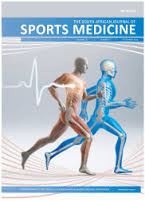Comparing critical speed modelling approaches and exploring relationships with match-play variables in elite male youth soccer players
DOI:
https://doi.org/10.17159/2078-516X/2021/v33i1a9738Abstract
Background: A novel bi-exponential method has emerged to estimate critical speed (CS) and D-prime (D′) from a 3-min all- out test (3MT).
Objectives: To compare CS analysis methods to determine whether parameter estimations were interchangeable. Reference values and relationships with key soccer match- play variables were explored.
Methods: Thirteen elite male youth (14-15 years old) players completed a 30 m shuttle run 3MT to estimate CS, D′, rate of speed decline time constant, maximal speed (Smax), time to Smax (tmax), and fatigue index (FI), using the traditional method and bi-exponential model on average (Bi-ExpAverage) and max speed settings (Bi-ExpMax-Speed). High-speed running (HSR) and sprinting distances and counts, and the number of accelerations were collected from two matches. Magnitude- based inferences (p < 0.05) with smallest worthwhile change of 0.2 effect sizes were used to analyse differences. Pearson’s and Spearman’s correlation coefficients were used to measure associations between CS model variables and match-play parameters.
Results: There were significant differences between the traditional method and both bi-exponential models for CS and D′, as well as between the bi-exponential models for all variables except tmax. Using the Bi-ExpAverage model, strong correlations (r = 0.70-0.73; p < 0.05) were observed for D′ and FI with the number of standardised and individualised HSRs, respectively. With the Bi-ExpMax-Speed model, there were strong correlations (r/ρ = 0.64-0.68; p < 0.05) between D′ and the number of standardised HSRs and sprints, and the number of individualised sprints.
Conclusion: There is a lack of interchangeability between analysis methods. It appears that D′ and FI from the bi- exponential models could be associated with high-intensity actions in soccer match-play.
Downloads
Downloads
Published
Issue
Section
License
The South African Journal of Sports Medicine reserves copyright of the material published. The work is licensed under a Creative Commons Attribution 4.0 (CC BY 4.0) International License. Material submitted for publication in the South African Journal of Sports Medicine is accepted provided it has not been published elsewhere. The South African Journal of Sports Medicine does not hold itself responsible for statements made by the authors.
How to Cite
- Abstract 575
- PDF 499






.png)